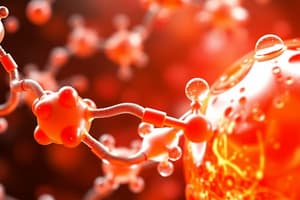Podcast
Questions and Answers
How do enzymes affect the activation energy of a biochemical reaction?
How do enzymes affect the activation energy of a biochemical reaction?
- Enzymes increase the activation energy, making the reaction faster.
- Enzymes lower the activation energy, thus accelerating the reaction. (correct)
- Enzymes completely remove the need for activation energy.
- Enzymes have no effect on the activation energy.
What is the primary role of an enzyme in a biological system?
What is the primary role of an enzyme in a biological system?
- To be consumed as a reactant in biochemical reactions.
- To increase the activation energy of reactions.
- To regulate and catalyze biochemical reactions. (correct)
- To increase the thermodynamic stability of substrates.
Which of the following statements accurately describes the nature of a catalyst in a chemical reaction?
Which of the following statements accurately describes the nature of a catalyst in a chemical reaction?
- A catalyst remains chemically unchanged at the end of the reaction, affecting only the reaction rate. (correct)
- A catalyst is consumed during the reaction, thereby becoming part of the product.
- A catalyst increases the energy of the products, making them less stable.
- A catalyst alters the thermodynamics of the reaction, changing the final product.
Consider a biochemical reaction where the product is thermodynamically more stable than the substrate. What is the role of an enzyme in this reaction?
Consider a biochemical reaction where the product is thermodynamically more stable than the substrate. What is the role of an enzyme in this reaction?
If a certain reaction has a high activation energy 'barrier', what is the most likely effect on the reaction rate if no enzyme is present?
If a certain reaction has a high activation energy 'barrier', what is the most likely effect on the reaction rate if no enzyme is present?
Which of the following is NOT a characteristic of enzymes as catalysts?
Which of the following is NOT a characteristic of enzymes as catalysts?
In a scenario where a substrate is converted into a product with the assistance of an enzyme, what happens to the enzyme after the reaction is complete?
In a scenario where a substrate is converted into a product with the assistance of an enzyme, what happens to the enzyme after the reaction is complete?
If an enzyme's active site is highly specific for a particular substrate, what is the most likely reason?
If an enzyme's active site is highly specific for a particular substrate, what is the most likely reason?
How does the presence of an enzyme typically affect the equilibrium constant of a reversible reaction?
How does the presence of an enzyme typically affect the equilibrium constant of a reversible reaction?
Which of the following scenarios would most likely result in a significant decrease in enzyme activity?
Which of the following scenarios would most likely result in a significant decrease in enzyme activity?
A biochemist discovers a new enzyme. Initial tests show that the enzyme activity increases as the substrate concentration increases, but only up to a certain point, after which the activity levels off. What is the most likely explanation for this observation?
A biochemist discovers a new enzyme. Initial tests show that the enzyme activity increases as the substrate concentration increases, but only up to a certain point, after which the activity levels off. What is the most likely explanation for this observation?
An enzyme is functioning at its optimum pH. How would significantly changing the pH, either increasing or decreasing it, most likely affect the enzyme?
An enzyme is functioning at its optimum pH. How would significantly changing the pH, either increasing or decreasing it, most likely affect the enzyme?
In a biochemical pathway, Enzyme A catalyzes the conversion of substrate X to intermediate Y, which is then converted to product Z by Enzyme B. If Enzyme A is inhibited, what is the most likely outcome?
In a biochemical pathway, Enzyme A catalyzes the conversion of substrate X to intermediate Y, which is then converted to product Z by Enzyme B. If Enzyme A is inhibited, what is the most likely outcome?
How does a catalyst increase the rate of a reaction?
How does a catalyst increase the rate of a reaction?
Flashcards
What are enzymes?
What are enzymes?
Biological catalysts that speed up biochemical reactions.
What is a catalyst?
What is a catalyst?
A substance that speeds up a reaction without being altered itself.
What is activation energy?
What is activation energy?
Enzymes lower this to speed up reactions.
What is a substrate?
What is a substrate?
Signup and view all the flashcards
What is a product?
What is a product?
Signup and view all the flashcards
Do enzymes change reaction outcome?
Do enzymes change reaction outcome?
Signup and view all the flashcards
Why do reactions occur?
Why do reactions occur?
Signup and view all the flashcards
Enzymes
Enzymes
Signup and view all the flashcards
Catalyst
Catalyst
Signup and view all the flashcards
Enzyme Action
Enzyme Action
Signup and view all the flashcards
Activation Energy
Activation Energy
Signup and view all the flashcards
Transition State
Transition State
Signup and view all the flashcards
Reaction driving force
Reaction driving force
Signup and view all the flashcards
Enzymes effect on reaction
Enzymes effect on reaction
Signup and view all the flashcards
Study Notes
- Enzymes are catalysts for biochemical reactions, regulated by an enzyme in a biological system.
- Catalysts affect the rate of a reaction but do not change the outcome and remain chemically unaltered.
- Enzymes accelerate biochemical reactions by lowering the activation energy.
- Reactions occur because the product is thermodynamically more stable than the substrate in terms of driving force
Enzymic Energy Profile
- Enzymes catalyze reactions by reducing activation energy.
- Activation energy reduction is achieved through the correct orientation of the substrate within the enzyme's active site.
- A smaller energy barrier remains after enzyme catalysis, this remains at 37 degrees celcius.
Properties of Enzymic Reactions
- Enzymatic reactions are fast, typically a million times faster (10^6-10^14 times) compared to uncatalyzed reactions.
- Enzymes are specific to their substrates and can differentiate between functional groups, isomers, and enantiomers.
- Enzymes are efficient in minimizing 'waste' by-products.
- Most enzyme reactions in the body occur at 37 °C and a pH of 7.4.
- Many drugs interact with enzymes and disrupt their function.
Enzyme Structure
- Enzymes are globular proteins with tertiary structures.
- Tertiary structures create active site pockets where reactants fit tightly and interact with the protein, lowering the activation energy of the reaction.
- Globular proteins bind one or more substances in an active site, including substrates and any needed cofactors.
Enzyme Nomenclature
- Enzymes are named and classified according to the reactions they catalyze.
- The suffix "-ase" is added to the substrate's name or a descriptive term for the reaction type.
- The International Union of Biochemistry categorizes enzymes into six major groups based on the type of chemical reactions they catalyze.
- Oxidoreductases
- Transferases
- Hydrolases
- Lyases
- Isomerases
- Ligases
- The 'Enzyme Commission' assigns a unique code number to each enzyme, e.g. 3.2.1.4.
- The first number indicates the class.
- The second number is the sub-class
- The third number is the sub-sub class
- The fourth number is the serial number of the enzyme in the sub-sub-class.
- EC 3.2.1.4 is Cellulase, which catalyzes the hydrolysis of cellulose.
- EC 1.1.1.1 is Alcohol dehydrogenase which is involved in the oxidation of alcohol.
Enzyme Cofactors
- Enzymes contain 20 amino acids and cofactors supply chemical groups not found in active sites, due to the limited chemistry.
- Many enzymes are inactive as a protein alone (apoenzymes) and require cofactors for activity.
- Cosubstrates bind weakly to the enzyme, are altered during the reaction, and dissociate from the active site; they are regenerated and recycled.
- Examples of Cosubstrates include: ATP ↔ ADP and NAD+ ↔ NADH.
- Prosthetic groups are tightly bound to the enzyme but must be regenerated in each catalytic cycle, for example, thiamine pyrophosphate (Vitamin B1) and haem.
Essential Ions
- Nearly a third of proteins require a metal ion for activity, hence the term metalloproteins or metalloenzymes.
- Fe2+ is found in haem (haemoglobin, myoglobin), are not enzymes
- Mg2+ is involved in many kinases which are reactions involving phosphorylations.
- Zn2+ is present in many enzymes that deal with oxidations/reductions and DNA recognition ("Zinc Fingers").
- Zinc fingers help proteins interact with DNA
- Copper, Manganese, Cobalt, and Molybdenum are other trace metals used by enzymes.
- The recommended daily intake of cobalt is 3 µg (as vitamin B12); deficiency leads to pernicious anemia (low RBC, neurological deterioration).
Enzyme Class 1: Oxidoreductases
- Catalyzes oxidation and reduction (REDOX) reactions.
- Enzymes in this class include dehydrogenases, oxidases, peroxidases, and reductases.
- Alcohol dehydrogenase oxidizes ethanol to ethanal, using a NAD+ cofactor and zinc metal ion.
- NAD+ is the biologically active form of vitamin B3 (niacin).
Alcohol Dehydrogenase: Mechanism
- The enzyme orientates all species correctly for reaction to occur.
- Nicotinamide adenine dinucleotide (NAD+) is oxidised.
- NADH is the reduced form, subsequently recycled after use.
Enzyme Class 2: Transferases
- Catalyzes functional group transfer reactions.
- Includes kinases, a family of enzymes that catalyze phosphorylation.
- Transcarboxylase [2.1.3.1] catalyzes the simultaneous conversion of to pyruvate.
- Catalyzes the simultaneous conversion of propionyl CoA to methyl malonyl CoA and oxaloacetate to pyruvate using biotin (vitamin H) cofactor
- Biotin is involved in enzymic carboxylation reactions and binds and manipulates a carboxylate group.
Enzyme Class 3: Hydrolases
- Catalyzes hydrolysis reactions (the breaking of a bond by the addition of water across it).
- Trypsin [3.4.21.4] mediates the hydrolysis of Lys-aa or Arg-aa peptide bonds.
- Trypsin is a serine protease enzyme which needs no cofactor.
- Trypsin contains sufficient functionality in its active site to perform the reaction unassisted (Asp-His-Ser: a catalytic triad).
Trypsin: Mechanism of Action
- Serine residue attacks the substrate peptide carbonyl bond, aided by Asp and His.
- Asp and His promote the nucleophilic attack and stabilize the resulting positive charge.
- The tetrahedral intermediate collapses.
- A water molecule, correctly oriented by interaction with His.
- Attacks the ester carbonyl group.
- The process liberates R-NH2, but the carboxyl residue remains bonded to the enzyme, via the serine.
- It is an ester linkage and easily hydrolysed.
- Active site amino acids are unchanged and ready for catalysis after the reaction.
- New amino and carboxylic groups are exposed by hydrolysis.
- Trypsin uses the chemical groups of its active site amino acid side chains to perform a complex reaction and needs no cofactor.
Enzyme Class 4: Lyases
- Catalyzes bond breaking reactions (but not hydrolytic or oxidative).
- For instance, L-Dopa decarboxylase [4.1.1.28] catalyzes decarboxylation of L-amino acids and is used as treatment for Parkinson's Disease.
- Pyridoxal phosphate (Vitamin B6, R= CH2OPO32-) is the coenzyme involved.
- The aldehyde group (CH=O) reacts with amines (drug) to form an imine (-CH=N-).
- Aldehydes are not available in amino acid side chains, therefore a vitamin is required.
Enzyme Class 5: Isomerases
- Catalyses isomerisation reactions, i.e. rearrangement of groups within a substrate molecule.
- Alanine racemase [5.1.1.1] found in bacteria and catalyses/interconversion of L and D alanine, both are essential for bacterial cell wall.
- Pyridoxal phosphate (Vitamin B6) is the coenzyme involved.
- Enzyme removes H from one face of amino acid (A) and replaces on opposite face (B).
Enzyme Class 6: Ligases
- Catalyzes the ligation (joining) of two substrates.
- Pyruvate carboxylase [EC 6.4.1.1] joins pyruvate with carbon dioxide to generate oxaloacetate.
- This is an important step in metabolism / the Krebs Cycle.
Summary of Enzymes
- Enzymes are globular proteins that catalyze a wide variety of important biochemical reactions.
- Protein folding creates a three-dimensional space suitable for substrate accommodation and active site amino acid residue orientation for reactivity.
- Some enzymes lack necessary chemical functional groups and require external help (cofactors) to function.
Studying That Suits You
Use AI to generate personalized quizzes and flashcards to suit your learning preferences.




